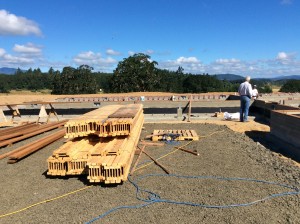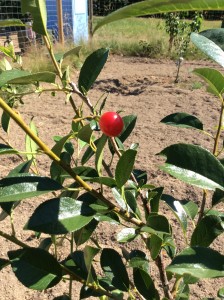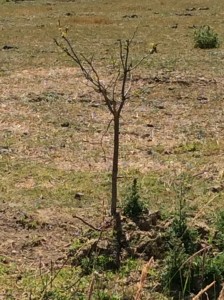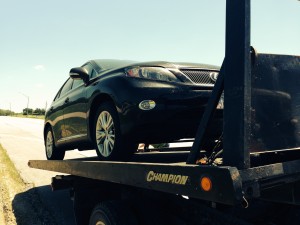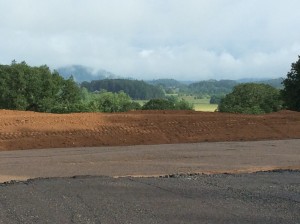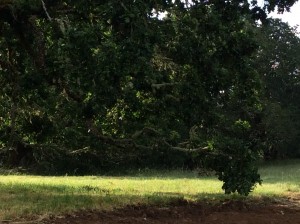Wednesday and we were on the road again. Going to water those trees, take down some weeds around the orchard, and begin a mulching process we learned about from Margie Lindbeck that was used at the Huntington Garden in Pasadena. Layers of wet cardboard surround each tree, on which is piled 4 to 6 inches of wood mulch. Except that description is retrospective — we know now what to do, but were going on a guess on that Wednesday, the 24th of June.
In what has become a routine, Larry opened the gate and went to pull the truck out of the barn. Continuing up the driveway in the car, I was thus by myself when I first saw the shocking spread of tansy over much of the fields where the cows have been.
Tansy is definitely bad stuff, and last year I am sure we had none at all. If this is what comes of overgrazing, something will have to change. I feel ashamed, sure that our neighboring farmers will be looking with disapproval at the evidence of careless husbandry. “Knew those city folks would be trouble. They’re probably thinking ‘oh, look at the pretty yellow flowers!'”
So. Tansy Ragwort, also knows as Stinking Willie, and Staggerwort. Which should give you some idea. It’s invasive, native to Asia, Africa, and Europe, appearing first in the Pacific Northwest in the 1920’s. All parts of the plant are highly toxic. The plant is biennial, and there are tricks to controlling isolated patches of it. Best are the biological agents, the cinnabar moth and ragwort flea beetle. They are both beautiful little creatures, the beetle iridescent gold, the moth dark gray with red accents. In the larval stage, the caterpillars are orange and black striped (Go Beavers!)
I can’t talk about this invasion without the uncomfortable thought that I, myself, am an invasive non-native arrival in this landscape. From a publication of the Grande Ronde Confederated Tribes about the Kalapuya, who were here before me:
“As a semi-nomadic people, the Kalapuya(s) lived in permanent winter homes and migrated throughout the Willamette Valley during the warmer months. They traded regularly with their Molalla and Cayuse neighbors as well as other Northern California, Oregon coast, and Columbia River tribes.
Camas root was the Kalapuyas’ most abundant and important staple. This “bulbous root plant resembles an onion in shape and consistency but is considerably more bland in taste,” according to “Cooking up Camas,” an article in Historic Marion. A member of the lily family, “camassia quamash” still grows in the Willamette Valley; it is known for its beautiful blue spring time blooms.
While they did not “cultivate” the land in today’s sense of the word, the Kalapuyas were familiar with land management practices such as controlled field burning. The article entitled “The Kalapuya: a Wealthy Way of Life” quotes Henry B. Zenk, a noted scholar of the Kalapuyas: “They slash burned just to make the country an open pasture. To make the habitat more conducive to elk, deer, camas, tarweed, and hazelnuts … The way they managed their land is something they had to work at. They were almost like a pre-agricultural society.”
Steve Smith, our conservation consultant drove up promptly at 11:00, and we put down our rakes to sit under the big oak and talk about OUR plans for caring for this land. We can basically take one of two paths, either agricultural, or toward pure conservation and restoration. Looking out at the consequences of grazing, it would seem a simple choice, but it isn’t. At the end of two hours, we’ve tentatively decided to see if a system of rotational grazing and pasturage improvement will be agreeable to Mark — Cow Guy, as you may remember. In exchange for forgiving any lease fee, we’d like him to be willing to move the cows maybe as often as every two weeks. Then, when these animals are gone in mid-July, Steve suggests we find someone who will be willing to pasture a herd of goats here to round out the grazing approach to conservation. We have an appointment with the director of Oregon Fish and Wildlife to consider signing a partnership with that organization. (A herd of goats? Sounds fun!)
As Steve was leaving, we had a quick look at several tansy plants, and found not a single larvae, caterpillar, or moth to be found. Bad news. We’ll see what Jarod, the F&W director has to suggest.
We went for lunch and stopped to acquire a few bags of mulch from Shonnard’s. Cut a nice piece of dry cardboard and fit it around the Liberty apple, the one looking most stressed. Piled on the mulch. If it’s good enough for the Huntington Garden! We started to water and got three trees done before the well ran dry (metaphorically). Seems we trip some breaker in the pump system and can’t see how to re-set it. So, it being 90 plus degrees, we decided to head back to Portland. Too hot!
At home, we learned that, to emulate the Huntington, one must pile great layers of wet corrugated cardboard around the trees, then pile on the mulch and water and water it. Going back tomorrow, as it is still in the 90’s, with a hot wind. Those trees will be thirsty, and if we can’t get the water to flow from the construction site, it’ll be back to Shonnard’s to fill our barrels and work the bucket brigade again. Onward!


